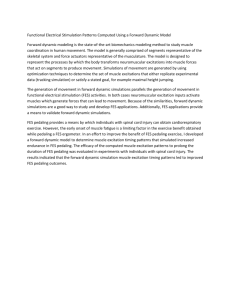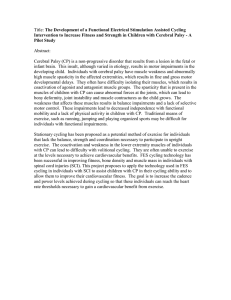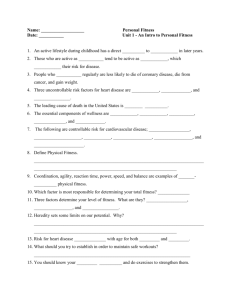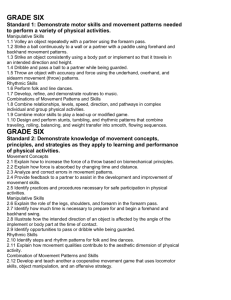Cardiorespiratory, Metabolic, and Biomechanical Responses During Functional Electrical Stimulation Leg Exercise:
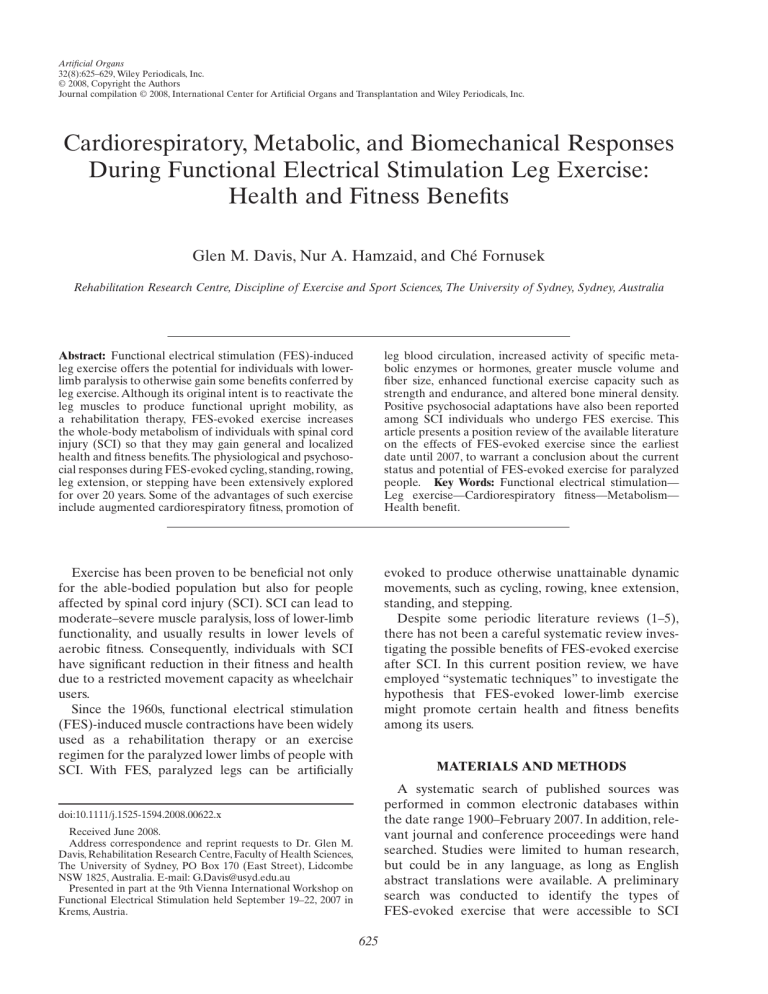
Artificial Organs
32(8):625–629, Wiley Periodicals, Inc.
© 2008, Copyright the Authors
Journal compilation © 2008, International Center for Artificial Organs and Transplantation and Wiley Periodicals, Inc.
Cardiorespiratory, Metabolic, and Biomechanical Responses
During Functional Electrical Stimulation Leg Exercise:
Health and Fitness Benefits
Glen M. Davis, Nur A. Hamzaid, and Ché Fornusek
Rehabilitation Research Centre, Discipline of Exercise and Sport Sciences, The University of Sydney, Sydney, Australia
Abstract: Functional electrical stimulation (FES)-induced leg exercise offers the potential for individuals with lowerlimb paralysis to otherwise gain some benefits conferred by leg exercise. Although its original intent is to reactivate the leg muscles to produce functional upright mobility, as a rehabilitation therapy, FES-evoked exercise increases the whole-body metabolism of individuals with spinal cord injury (SCI) so that they may gain general and localized health and fitness benefits. The physiological and psychosocial responses during FES-evoked cycling, standing, rowing, leg extension, or stepping have been extensively explored for over 20 years. Some of the advantages of such exercise include augmented cardiorespiratory fitness, promotion of leg blood circulation, increased activity of specific metabolic enzymes or hormones, greater muscle volume and fiber size, enhanced functional exercise capacity such as strength and endurance, and altered bone mineral density.
Positive psychosocial adaptations have also been reported among SCI individuals who undergo FES exercise. This article presents a position review of the available literature on the effects of FES-evoked exercise since the earliest date until 2007, to warrant a conclusion about the current status and potential of FES-evoked exercise for paralyzed people.
Key Words: Functional electrical stimulation—
Leg exercise—Cardiorespiratory fitness—Metabolism—
Health benefit.
Exercise has been proven to be beneficial not only for the able-bodied population but also for people affected by spinal cord injury (SCI). SCI can lead to moderate–severe muscle paralysis, loss of lower-limb functionality, and usually results in lower levels of aerobic fitness. Consequently, individuals with SCI have significant reduction in their fitness and health due to a restricted movement capacity as wheelchair users.
Since the 1960s, functional electrical stimulation
(FES)-induced muscle contractions have been widely used as a rehabilitation therapy or an exercise regimen for the paralyzed lower limbs of people with
SCI. With FES, paralyzed legs can be artificially doi:10.1111/j.1525-1594.2008.00622.x
Received June 2008.
Address correspondence and reprint requests to Dr. Glen M.
Davis, Rehabilitation Research Centre, Faculty of Health Sciences,
The University of Sydney, PO Box 170 (East Street), Lidcombe
NSW 1825, Australia. E-mail: G.Davis@usyd.edu.au
Presented in part at the 9th Vienna International Workshop on
Functional Electrical Stimulation held September 19–22, 2007 in
Krems, Austria.
evoked to produce otherwise unattainable dynamic movements, such as cycling, rowing, knee extension, standing, and stepping.
Despite some periodic literature reviews (1–5), there has not been a careful systematic review investigating the possible benefits of FES-evoked exercise after SCI. In this current position review, we have employed “systematic techniques” to investigate the hypothesis that FES-evoked lower-limb exercise might promote certain health and fitness benefits among its users.
625
MATERIALS AND METHODS
A systematic search of published sources was performed in common electronic databases within the date range 1900–February 2007. In addition, relevant journal and conference proceedings were hand searched. Studies were limited to human research, but could be in any language, as long as English abstract translations were available. A preliminary search was conducted to identify the types of
FES-evoked exercise that were accessible to SCI
626 G.M. DAVIS ET AL.
FIG. 1.
Muscle fiber composition changes following FES-evoked cycling (8).
individuals, as well as the available outcomes of the activities. This preliminary search also generated the inclusion criteria key words utilized in the systematic search of databases.
The collective conclusions of the obtained randomized controlled trials (RCTs) and quasi-RCTs were not sufficient to position the status of the topic under question.The authors finally included other nonrandomized or controlled studies, which mainly comprised clinical trials, to encompass all available scientific evidence pertaining to FES-induced exercise.
Health and fitness outcomes were divided into six broad domains: (i) skeletal muscle morphology and biochemistry; (ii) cardiovascular and hemodynamic responses; (iii) generalized metabolic responses, including aerobic fitness; (iv) bone mineral density and stiffness; (v) functional changes in exercise capacity; and (vi) psychosocial outlook.
Only two of the categories will be reported herein due to restrictions of paper length, but all are reported in detail in a full-length paper under peer review.
RESULTS
From over 865 potentially relevant publications,
177 fulfilled the primary inclusion criteria. Only one study was an RCT, and 31 quasi-experimental investigations were identified. The remainder were cross-sectional or crossover research designs, which included clinical trials and patient surveys.
DISCUSSION
Skeletal muscle morphology and biochemistry
Six primary studies, meeting the inclusion criteria, collectively suggested that FES exercise may reverse
Artif Organs, Vol. 32, No. 8, 2008 or ameliorate muscle atrophy, and that muscle fibers can shift their morphological characteristics toward that of sedentary, able-bodied people. Baldi and colleagues (6) demonstrated via an RCT that 6 months of FES cycling could prevent muscle atrophy, compared to FES isometric muscle contractions or no exercise at all. SCI individuals who performed regular cycling realized no reductions in their lower limb and glutei lean mass after 3 months of training and after 6 months had significantly increased these measures of muscularity. Similar results were found by other authors in controlled and quasiexperimental studies.
Factors that affect muscle properties during FES exercise include external loading and neuromuscular stimulation frequencies. A controlled study by
Crameri and coworkers (7) revealed that isometric
FES training, with a high external loading, significantly increased muscle fiber cross-sectional areas and produced a shift toward type I (slow-twitch oxidative) fibers with higher aerobic enzyme activity and muscle oxygenation. Other authors have shown this to be particularly effective for low-frequency FES isometric training in terms of improving fatigue resistance. In general, a number of reports have demonstrated that muscle morphology and biochemistry, sampled through needle biopsy, are significantly altered after FES exercise training toward characteristics of able-bodied individuals. With regular FES cycling exercise, muscle fiber shifts toward greater fatigue resistance (i.e., from equal amounts of type
IIB and type IIA fibers to a majority of type IIA)
(Fig. 1) (8).
In summary, one randomized controlled study, either randomized or controlled investigations, and quasi-experimental evidence all generally support
FES LEG EXERCISE: HEALTH AND FITNESS BENEFITS positive muscle sequelae in adherents to FES exercise training programs. These data lend support to our position statement that such exercise programs promote peripheral muscle health and fitness benefits for the SCI population.
Generalized metabolic responses, including aerobic fitness
In general, the metabolic responses during FESevoked leg exercise are different from those responses elicited during a similar modality of leg exercise performed voluntarily. These differences of physiological responses may be explained by two principal underlying factors. First, significant muscle atrophy and fiber type shift to predominantly fasttwitch morphology (i.e., IIA, IIB, IIX), as well as the biochemical adaptations that accompany these, yield working muscles that are smaller and less able to engender aerobic metabolism during exercise.
Second, lack of central neural drive to below the spinal lesion results in usual control of local blood flow being absent or attenuated (i.e., predominantly sympathetic vasoconstriction to inactive vascular beds).
Nevertheless, six primary studies meeting the inclusion criteria of randomized, controlled, or randomized controlled designs clearly demonstrated enhanced aerobic metabolism after variable periods of FES exercise training. In general, there is a trend for these improvements of exercise metabolism to be greater in individuals with lower initial aerobic fitness levels (e.g., tetraplegics, older SCI). For example, De
Carvalho and Cliquet (9) performed a controlled study whereby subjects with tetraplegia undertook either FES treadmill training (with partial body weight support) or no exercise for 6 months duration. Following training, the FES training group had increased their oxygen uptake (L/min) and exercise metabolism (J/kg/s) by 36 and 33%, respectively, during treadmill gait. In contrast, the control group realized only a small increase of their oxygen uptake and no change of metabolism during FES-evoked knee extension exercise.
In a previous study, Hooker and coworkers (10) observed that sedentary paraplegics and tetraplegics increased their peak oxygen uptake by 10% after only twice weekly FES cycling over 19 weeks. Additionally, the authors observed a significant decrease in markers for anaerobic metabolism accompanying a trend to lower lactate-driven expired ventilation during submaximal effort cycling exercise—these presume a shift to higher aerobic leg metabolism accompanying the fiber-type changes noted by other researchers (7,8).
627
FIG. 2.
Peak oxygen uptake before FES leg cycling, after FES leg cycling only, and after hybrid leg cycling + arm crank training
(11).
There is strong evidence that FES-induced leg exercise when combined with voluntary arm effort
(“hybrid” exercise) is a potent stressor to evoke changes of aerobic fitness and metabolism. During arm exercise with concurrent FES cycling or FES rowing, oxygen uptake is higher than arm or leg exercise alone. In a nonrandomized controlled trial,
Mutton and colleagues (11) demonstrated that FES cycling alone increased aerobic fitness after SCI, but when combined with arm cranking, peak oxygen uptake was further incremented (Fig. 2). Interestingly, there was a trend for arm exercise peak oxygen uptake to be augmented after hybrid exercise (Fig. 2,
), but not after FES leg cycling alone (Fig. 2,
), indicating there is no “cross transfer of training effect” (also known as cross training) from leg exercise to arm performance in SCI individuals. In other quasi-experimental findings and in a randomized study, similar results have been noted for hybrid exercise comprising rowing, cycling, and stepping.
Generally, all literature surveyed lends support to the view that FES-evoked leg exercise promotes positive metabolic responses and enhances aerobic fitness for people with SCI. Randomized and controlled investigations and quasi-experimental evidence of different modes of FES-evoked exercise conditioning all contribute to the same conclusion.
Biomechanical considerations
Recent evidence has emerged that some of the major physiological adaptations that transpire after
Artif Organs, Vol. 32, No. 8, 2008
628 G.M. DAVIS ET AL.
FES-evoked exercise may be related to biomechanical factors. In particular, both external load on the muscle (7) and the rate/cadence of exercise (12,13) contribute to altered muscle forces, morphological adaptation, and external power production.
Fornusek and colleagues (12,13) have shown that the “force–velocity” relationship of voluntarily activated muscle is also evident for muscles stimulated via FES. In a randomized study, the authors demonstrated higher pedal torques at slower FES cycling cadences (Fig. 3, left panel). In contrast, greater power outputs were observed at higher cycling cadences (Fig. 3, right panel). In another randomized investigation, Fornusek and Davis (12) observed differing rates of fatigue over 35 min of leg cycling between torque production and power output at different pedal cadences. Whether higher muscle forces or greater external power outputs are more important for beneficial physiological adaptations to emerge is currently unknown.
Another biomechanical consideration is which mode of exercise (e.g., cycling, rowing, knee extension, or stepping) has the greatest “dose potency” to elicit beneficial adaptations to muscle, general metabolism, bone, and psychosocial outcomes? While some of these modes lend themselves to hybrid arm and leg exercise to a greater degree, and thereby might augment aerobic fitness more, there is no sufficient evidence currently to recommend one as superior over the others.
Irrespective of the FES exercise mode, by producing artificially evoked movement of their paralyzed legs, people with SCI can improve their health and fitness. Figure 4 shows one model illustrating the
FIG. 3.
Instantaneous peak torque and peak power during constant-velocity FES cycling at 10, 30, and 50 rev/min. Symbols
* and † denote difference from 50 and 10 rev/min, respectively
( P
<
0.05) (12).
Artif Organs, Vol. 32, No. 8, 2008
FIG. 4.
Relationship between health and fitness outcomes following FES-evoked exercise (14).
interrelationships of some of the primary health and fitness outcomes after FES-evoked exercise.
CONCLUSION
In the two domains of health and fitness outcomes reported herein, positive effects of FES-evoked exercise were identified. Even though increments of health and fitness were lower than observed for agematched able-bodied cohorts performing voluntary exercise, there were significant trends for altered skeletal muscle size and morphology, enhanced metabolism, including aerobic fitness, greater functional exercise capacity, and improved psychosocial outlook. Less consistently observed were positive changes of bone mineral density and stiffness after
FES training.
Acknowledgments: A portion of this work has been drawn from a systematic review conducted by the second author, as a component of her PhD studies. The second author received funding from a JPA Malaysian Government Scholarship. This research was also supported by an NSW Ministry of
Science and Medical Research Program Grant.
REFERENCES
1. Glaser RM. Functional neuromuscular simulation. Exercise conditioning of spinal cord-injured patients.
Int J Sports Med
1994;15:142–8.
2. Andrews BJ, Wheeler GD. Functional and therapeutic benefits of electrical stimulation after spinal cord injury.
Curr
Opin Neurobiol 1995;8:461–6.
3. Janssen TWJ, Glaser RM, Shuster DB. Clinical efficacy of electrical stimulation exercise training: effects on health, fitness and function.
Top Spinal Cord Inj Rehabil 1998;3:33–49.
4. Raymond J, Crameri R. Electrical stimulation for individuals with spinal cord injury.
Am J Med Sports 2001;4:209–22.
5. Wilder RP, Jones EV, Wind TC, Edlich RF. Functional electrical stimulation cycle ergometer exercise for spinal cord-injured patients.
J Long Term Eff Med Implants
2002;12:161–4.
FES LEG EXERCISE: HEALTH AND FITNESS BENEFITS
6. Baldi JC, Jackson JC, Moraille RD, Mysiw WJ. Muscle atrophy is prevented in patients with acute spinal cord injury using functional electrical stimulation.
Spinal Cord 1998;36:
463–9.
7. Crameri RM, Cooper P, Sinclair PJ, Bryant G, Weston A.
Effect of load during electrical stimulation training in spinal cord injury.
Muscle Nerve 2004;29:104–11.
8. Andersen JL, Mohr T, Biering-Sorensen F, et al. Myosin heavy chain isoform transformation in single fibres from m. vastus lateralis in spinal cord injured individuals: effects of long-term functional electrical stimulation (FES).
Pflugers Arch 1996;
431:513–8.
9. De Carvalho CL, Cliquet A. Energy expenditure during rest and treadmill gait training in quadriplegic subjects.
Spinal
Cord 2005;43:658–63.
10. Hooker S, Scremin E, Mutton DL, et al. Peak and submaximal physiologic responses following electrical stimulation leg cycle ergometer training.
J Rehabil Res Dev 1995;32:361–6.
629
11. Mutton DL, Scremin AM, Barstow TJ, et al. Physiologic responses during functional electrical stimulation leg cycling and hybrid exercise in spinal cord injured subjects.
Arch Phys
Med Rehabil 1997;78:712–8.
12. Fornusek C, Davis GM. Maximising muscle forces via low cadence FES-cycling.
J Rehabil Med 2004;36:232–7.
13. Fornusek C, Sinclair PJ, Davis GM. The force–velocity relationship of paralyzed quadriceps muscles during functional electrical stimulation cycling.
J Neuromodulation 2007;10:68–
75.
14. Hamzaid NA, Davis GM. Health and fitness benefits of functional electrical stimulation-evoked leg exercise on leg-paralysed individuals. International Sports Science Conference 2006, Malaysia.
Artif Organs, Vol. 32, No. 8, 2008
